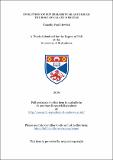Files in this item
Evolution of supermassive black holes : the role of galaxy mergers
Item metadata
| dc.contributor.advisor | Wild, Vivienne | |
| dc.contributor.author | Hewlett, Timothy Paul | |
| dc.coverage.spatial | xii, 142 p. | en_US |
| dc.date.accessioned | 2019-06-18T13:29:01Z | |
| dc.date.available | 2019-06-18T13:29:01Z | |
| dc.date.issued | 2019-06-24 | |
| dc.identifier.uri | https://hdl.handle.net/10023/17920 | |
| dc.description.abstract | In this thesis the connections between galaxy mergers and the growth of supermassive black holes (SMBHs) are investigated. In chapter 2 we investigate the links between galaxy mergers and active galactic nuclei (AGN) as a function of luminosity, using visual classification of galaxy images and a new measure of morphological disturbance to identify mergers, testing the hypothesis that cataclysmic events such as mergers are required to drive the most rapid periods of accretion. We find no correlation between merger fraction and AGN luminosity, nor any difference in the total merger fractions of AGN and matched control galaxies. We also explore the possibility that the role of galaxy mergers evolves through cosmic time over the redshift range 0.5-2.2, finding a modest evolution, with higher redshift AGN more likely to be found in mergers than controls with 99% confidence. In chapter 3 we compare samples of simulated (Illustris) galaxies to real observations, exploring the efficacy of different techniques of merger-identification as a function of merger parameters (mass ratio, time elapsed since the merger, stellar mass, star formation rate etc.). Detailed analysis of the ability of structural parameters and visual classification to identify mergers allows for reinterpretation of observational studies in which AGN merger fractions are measured. We find the intrinsic merger fractions in relevant studies are likely several times higher than reported, with 50 20% of AGN in the local Universe triggered by galaxy mergers. In chapter 4 AGN are selected in the optical, infrared and radio to investigate the role of mergers in triggering AGN in different physical environments. We use structural parameters to estimate merger fractions. It is found that infrared-selected AGN are more likely to be associated with mergers than their controls, optically selected AGN are equivalent to controls and radio-selected AGN show fewer signs of interactions than their controls. Collectively, this is interpreted as evidence that a substantial fraction of SMBH growth is driven by galaxy mergers, but care needs to be taken to control for various observational biases, which can hide or dilute real underlying causal relations. | en_US |
| dc.language.iso | en | en_US |
| dc.publisher | University of St Andrews | |
| dc.subject.lcc | QB843.B55H4 | |
| dc.subject.lcsh | Black holes (Astronomy) | en |
| dc.subject.lcsh | Galaxy mergers--Mathematical models | en |
| dc.subject.lcsh | Active galactic nuclei | en |
| dc.title | Evolution of supermassive black holes : the role of galaxy mergers | en_US |
| dc.type | Thesis | en_US |
| dc.contributor.sponsor | Science and Technology Facilities Council (STFC) | en_US |
| dc.type.qualificationlevel | Doctoral | en_US |
| dc.type.qualificationname | PhD Doctor of Philosophy | en_US |
| dc.publisher.institution | The University of St Andrews | en_US |
| dc.identifier.doi | https://doi.org/10.17630/10023-17920 |
This item appears in the following Collection(s)
Items in the St Andrews Research Repository are protected by copyright, with all rights reserved, unless otherwise indicated.

